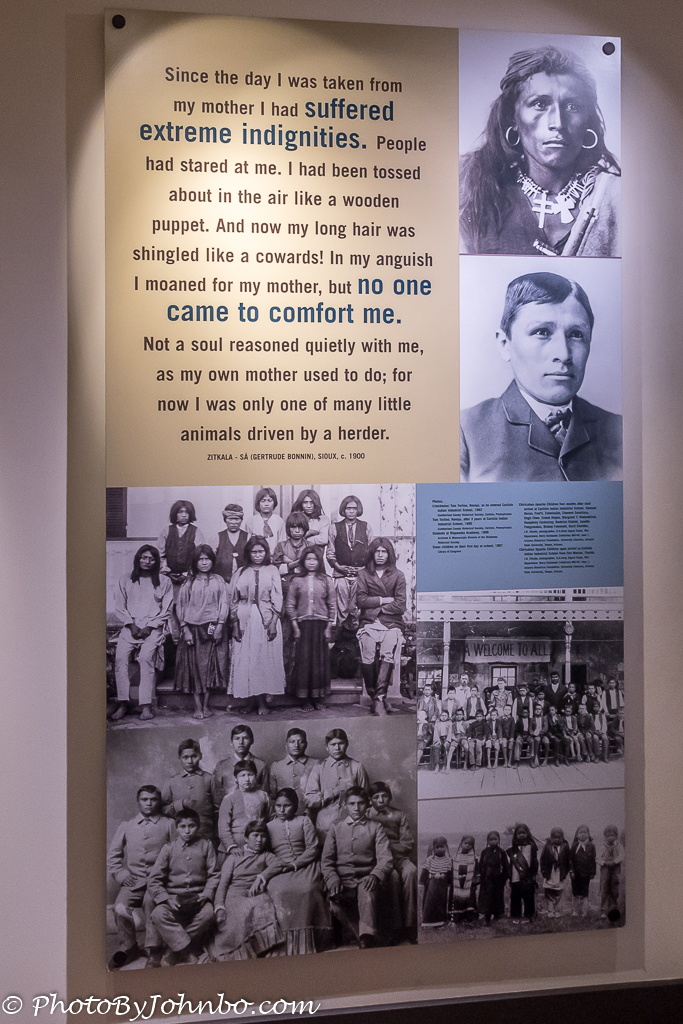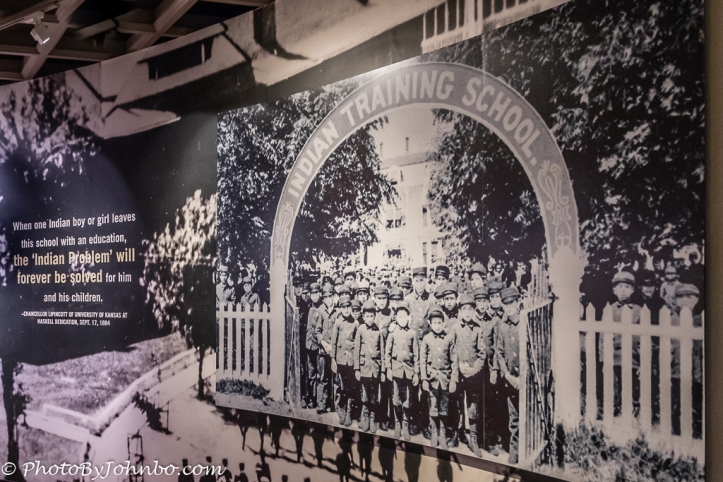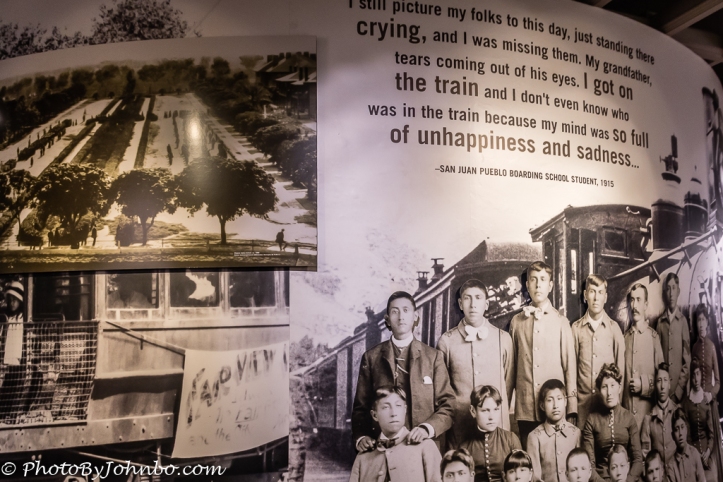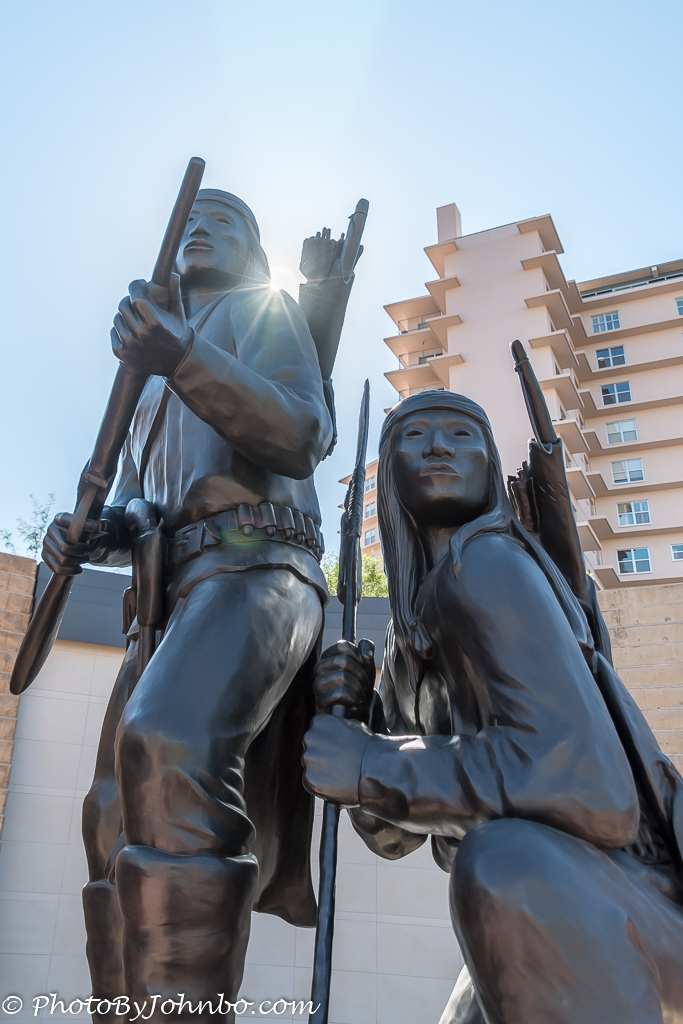The great southwest has been populated by indigenous peoples for centuries. The Heard Museum focuses on these Native Americans and features their history, culture and art. One of the standing sculptures features Native Americans serving their country as soldiers in World War II. Indeed, one of the heroes who raised the US flag on Iwo Jima was Pima Indian, Ira Hayes… but I digress. We visited the Heard Museum in 2015. You can review that article and photos here.
 The Indian boarding schools began in 1879, and over they years, they numbered in the hundreds. Though most are gone now, the Bureau of Indian Affairs (BIA) still runs four boarding schools, Chemawa Indian School at Forest Grove, OR, Sherman Indian School at Riverside, CA, Flandreau Indian School at Flandreau, SD, and Riverside Indian School at Anadarko, OK. The exhibit above features a bunk from one of the dorms.
The Indian boarding schools began in 1879, and over they years, they numbered in the hundreds. Though most are gone now, the Bureau of Indian Affairs (BIA) still runs four boarding schools, Chemawa Indian School at Forest Grove, OR, Sherman Indian School at Riverside, CA, Flandreau Indian School at Flandreau, SD, and Riverside Indian School at Anadarko, OK. The exhibit above features a bunk from one of the dorms.
 Several large display posters feature quotes from early boarding school residents. The above poster reads, “Since the day I was taken from my mother I had suffered extreme indiginities. People had stared at me. i had been tossed about in the air like a wooden puppet. And now my long hair was shingled like a cowards! In my anguish I moaned for my mother, but no one came to comfort me. Not a soul reasoned quietly with me, as my own mother used to do; for now I was only one of the many little animals driven by a herder.”
Several large display posters feature quotes from early boarding school residents. The above poster reads, “Since the day I was taken from my mother I had suffered extreme indiginities. People had stared at me. i had been tossed about in the air like a wooden puppet. And now my long hair was shingled like a cowards! In my anguish I moaned for my mother, but no one came to comfort me. Not a soul reasoned quietly with me, as my own mother used to do; for now I was only one of the many little animals driven by a herder.”
The above quote is from Impressions Of An Indian Childhood, written by Zitkala-Sa (aka Gertrude Simmons Bonnin), a Native American writer, editor, musician and teacher who was born and raised on the Yankton Sioux Reservation in South Dakota.
 Only the blacks and the Indians were segregated from the general population at schools in the 19th and 20th centuries. The Civil Rights Movement of the 1960’s integrated blacks into the school systems, but to this day, there are still four BIA boarding schools for Native Americans. The quote on the panel above reads, “When one Indian boy or girl leaves this school with an education, the ‘Indian Problem’ will forever be solved for him and his children.” – Joshua Lippincott on the dedication of the Haskell Institute, 1884.
Only the blacks and the Indians were segregated from the general population at schools in the 19th and 20th centuries. The Civil Rights Movement of the 1960’s integrated blacks into the school systems, but to this day, there are still four BIA boarding schools for Native Americans. The quote on the panel above reads, “When one Indian boy or girl leaves this school with an education, the ‘Indian Problem’ will forever be solved for him and his children.” – Joshua Lippincott on the dedication of the Haskell Institute, 1884.
Lippincott worked with the firmly established Carlisle Indian School in Pennsylvania. He left Carlisle for Lawrence, Kansas and was elected Chancellor of the University of Kansas. Following many of the principles learned at the Carlisle School and under Lippincott’s leadership, Haskell Institute started as an Indian boarding school in 1884. Lippincott, however, deviated from the Carlisle model by removing the Indian completely from the vicinity of their home and reservations. Today, Haskell Indian Nations University is a federally operated tribal university and offers associate and bachelor degrees.
 The exhibit features many of the commonalities between the Indian schools and mainstream education of the time. However the focus on segregation brought a new understanding to me of how the American Indian population has been treated. The quote in the above panel reads, “I still picture my folks to this day, just standing there crying, and I was missing them. My grandfather, tears coming out of his eyes. I got on the train and I don’t even know who was in the train because my mind was so full of unhappiness and sadness…” – San Juan Pueblo Boarding School Student, 1915.
The exhibit features many of the commonalities between the Indian schools and mainstream education of the time. However the focus on segregation brought a new understanding to me of how the American Indian population has been treated. The quote in the above panel reads, “I still picture my folks to this day, just standing there crying, and I was missing them. My grandfather, tears coming out of his eyes. I got on the train and I don’t even know who was in the train because my mind was so full of unhappiness and sadness…” – San Juan Pueblo Boarding School Student, 1915.
From the barber chair where students lost their long locks to the band uniforms, the exhibits focus on life in the schools for the large number of Native Americans who were taken from their homes and families, their culture and history taken away or minimized in an effort to assimilate them into the general population, yet ironically when they graduated, they went back to their reservations. More about this eye-opening exhibit can be found on the Heard Museum’s website, here. The gallery of images below features more views of the boarding school exhibit as well as some of the other exhibits in the museum. Click on an image to enlarge it and to scroll through the gallery.
John Steiner
















Thanks for a new understanding.